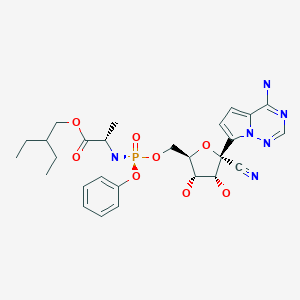Attribution Statement: LactMed is a registered trademark of the U.S. Department of Health and Human Services.
NCBI Bookshelf. A service of the National Library of Medicine, National Institutes of Health.
Drugs and Lactation Database (LactMed®) [Internet]. Bethesda (MD): National Institute of Child Health and Human Development; 2006-.
CASRN: 1809249-37-3

Drug Levels and Effects
Summary of Use during Lactation
Information from 5 patients indicate that milk levels of remdesivir and its active metabolite are very low in milk. Additionally, remdesivir is poorly absorbed orally, and the metabolite is only partially absorbed orally, so infants are not likely to absorb clinically important amounts of the drug from milk. Newborn infants have received intravenous remdesivir therapy for Ebola and for COVID-19 with no serious adverse drug reactions and it is FDA approved for use in infants of at least 28 days and weighing 3 kg.[1-3] Infants exposed via breastmilk have also not had any reported adverse reactions. Given this information, mothers receiving remdesivir do not need to avoid nursing, but until more data are available, remdesivir should be used with careful infant monitoring during breastfeeding.[4] The most common adverse effects reported after intravenous infusion include elevated aminotransferase and bilirubin levels and other liver enzyme elevations, diarrhea, rash, renal impairment and hypotension.
Drug Levels
Maternal Levels. Two days after delivery, a woman was diagnosed with a SARS-CoV-2 infection. She was given 200 mg of remdesivir on the first day of therapy, then 100 mg daily for 4 more days. Although not stated, all doses are presumed to have been given intravenously. On day 5 of therapy, milk was collected just before the dose and 1, 3, 6, and 24 hours after the last dose. Remdesevir and its metabolite GS-441524 were measured in milk. The concentration of remdesivir in milk was 1.29 mcg/L one hour before administration on day 5, but undetectable (<0.5 mcg/L) in the other samples. The concentration of the active metabolite GS-441524 in the milk samples were 13.5 mcg/L before the fifth dose, 285 mcg/L at 3 hours after the dose and 64.3 mcg/L at 24 hours after the dose. The authors estimated the relative infant doses of remdesevir and GS-441524 in breastmilk as 0.007% and 1.6%, respectively. The half-life of GS-441524 in milk was estimated to be 9.3 hours.[5]
Four women with COVID-19 who received remdesivir provided 17 milk samples for analysis of remdesivir and its active metabolite GS-441524. All of the milk samples had unquantifiable (<100 mcg/L) concentrations of remdesevir. Eleven of the samples contained unquantifiable (<100 mcg/L) concentrations of GS-441524. The highest concentration of the metabolite in the remaining 6 samples from one woman was 168 mcg/L. Using this “worst-case” value, the infant dose would be 25.2 mcg/kg daily, which would be a relative infant dose of <5%.[6]
Infant Levels. Relevant published information was not found as of the revision date.
Effects in Breastfed Infants
The manufacturer reports that 11 breastfed infants were exposed to remdesevir in breastmilk from pharmacovigilance reports. The reports do not indicate adverse effects on breastfed infants from exposure to remdesivir and its metabolite through breastmilk.
Effects on Lactation and Breastmilk
Relevant published information was not found as of the revision date.
Alternate Drugs to Consider
References
- 1.
- Dörnemann J, Burzio C, Ronsse A, et al. First newborn baby to receive experimental therapies survives Ebola virus disease. J Infect Dis 2017;215:171-4. [PMC free article: PMC5583641] [PubMed: 28073857]
- 2.
- Mulangu S, Dodd LE, Davey RT, Jr, et al. A randomized, controlled trial of Ebola virus disease therapeutics. N Engl J Med 2019;381:2293-303. [PMC free article: PMC10680050] [PubMed: 31774950]
- 3.
- Frauenfelder C, Brierley J, Whittaker E, et al. Infant with SARS-CoV-2 infection causing severe lung disease treated with remdesivir. Pediatrics 2020;146:e20201701. [PubMed: 32554811]
- 4.
- Aleissa MM, Silverman EA, Paredes Acosta LM, et al. New perspectives on antimicrobial agents: Remdesivir treatment for COVID-19. Antimicrob Agents Chemother 2021;65:e01814-20. [PMC free article: PMC7927874] [PubMed: 33139290]
- 5.
- Wada YS, Saito J, Hashii Y, et al. Remdesivir and human milk: A case study. J Hum Lact 2022;38:248-51. [PubMed: 35189734]
- 6.
- Bertrand K, Sepulveda Y, Spiegel BJ, et al. Concentrations of remdesivir and GS-441524 in human milk from lactating individuals diagnosed with COVID-19. Pediatr Res 2024. [PubMed: 38347172]
Substance Identification
Substance Name
Remdesivir
CAS Registry Number
1809249-37-3
Disclaimer: Information presented in this database is not meant as a substitute for professional judgment. You should consult your healthcare provider for breastfeeding advice related to your particular situation. The U.S. government does not warrant or assume any liability or responsibility for the accuracy or completeness of the information on this Site.
- User and Medical Advice Disclaimer
- Drugs and Lactation Database (LactMed) - Record Format
- LactMed - Database Creation and Peer Review Process
- Fact Sheet. Drugs and Lactation Database (LactMed)
- Drugs and Lactation Database (LactMed) - Glossary
- LactMed Selected References
- Drugs and Lactation Database (LactMed) - About Dietary Supplements
- Breastfeeding Links
- PMCPubMed Central citations
- PubChem SubstanceRelated PubChem Substances
- PubMedLinks to PubMed
- Viroinformatics approach to explore the inhibitory mechanism of existing drugs repurposed to fight against COVID-19.[Eur J Pharmacol. 2020]Viroinformatics approach to explore the inhibitory mechanism of existing drugs repurposed to fight against COVID-19.Bibi N, Gul S, Ali J, Kamal MA. Eur J Pharmacol. 2020 Oct 15; 885:173496. Epub 2020 Aug 22.
- Review COVID-19 Vaccines.[Drugs and Lactation Database (...]Review COVID-19 Vaccines.. Drugs and Lactation Database (LactMed®). 2006
- Review Pibrentasvir.[Drugs and Lactation Database (...]Review Pibrentasvir.. Drugs and Lactation Database (LactMed®). 2006
- Review Domperidone.[Drugs and Lactation Database (...]Review Domperidone.. Drugs and Lactation Database (LactMed®). 2006
- Review Cocaine.[Drugs and Lactation Database (...]Review Cocaine.. Drugs and Lactation Database (LactMed®). 2006
- Remdesivir - Drugs and Lactation Database (LactMed®)Remdesivir - Drugs and Lactation Database (LactMed®)
Your browsing activity is empty.
Activity recording is turned off.
See more...
